|
||||||
|
SETARIA. Bristle-grasses. [Poaceae] |
|
Nine species of Setaria are recorded in Britain. All are introduced and include Adherent Bristle-grass (S. adhaerens), Nodding Bristle-grass (S. faberi), Foxtail Bristle-grass (S. italica), Yellow Bristle-grass (S. pumila), Rough Bristle-grass (S. verticillata), Green Bristle-grass (S. viridis) and Knotroot Bristle-grass (S. parviflora). Nine British miners are recorded on Setaria. Nearly 100 British miners or possible miners are recorded on grasses in Britain. A key to the European miners recorded on Setaria is provided in Bladmineerders van Europa. It is recommended that adults of all miners on grasses be reared to be certain of their identity.
|
Key for the identification of the known mines of British |
1a > Leaf-miner: Mine long, narrow, whitish. Pupation internal. Puparium yellowish brown, anterior spiracles projecting through the epidermis |
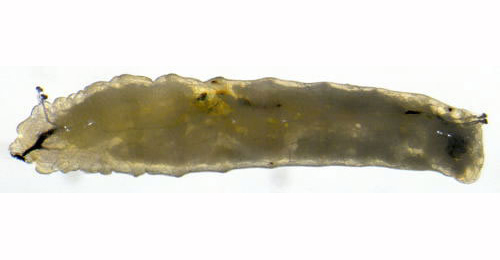 Chromatomyia nigra larva, lateral Image: © Willem Ellis (Bladmineerders van Europa) |
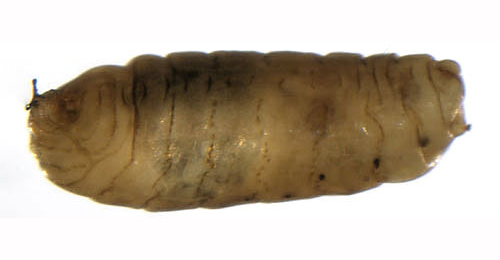 Chromatomyia nigra pupa, lateral Image: © Willem Ellis (Bladmineerders van Europa) |
|
Chromatomyia nigra (Meigen, 1830) [Diptera: Agromyzidae]. |
1b > Leaf-miner: Pupation external or internal. If internal then anterior posterior spiracles not projecting through the epidermis. |
2a > Leaf-miner: Broad elongated mine; the form is dependent of the leaf form of the host plant. Frass green. Usually a number of larvae together in a mine. Pupation in the mine |
|
Cerodontha incisa (Meigen, 1830) [Diptera: Agromyzidae]. |
2c > Leaf-miner: Larvae feed singly, forming an upper surface linear-blotch mine. Pupation either internal or external, with the puparium loosely glued to the leaf (Spencer, 1976: 91). Oviposition near the leaf margin, at some distance from the leaf tip. From there develops an upper-surface corridor-blotch. At first the mine ascends as a narrow corridor towards the leaf tip, then the direction turns and the mine, steadily widening, descends in the direction of the leaf base. Frass irregular, in rather coarse grains. Larva solitary. Pupation mostly outside the mine; in that case the puparium often sticks to the leaf. |
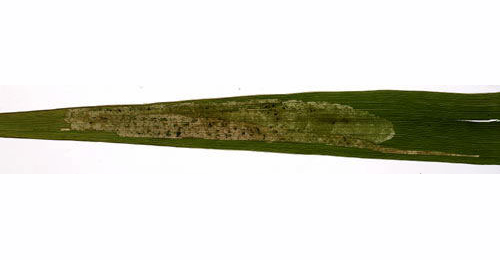 Mine of Agromyza albipennis on Phalaris arundinacea Image: © Willem Ellis (Bladmineerders van Europa) |
|
Agromyza albipennis Meigen, 1830 [Diptera: Agromyzidae]. |
2d > Leaf-miner: Larvae either singly or several in leaf, then forming large blotch, feeding first up and then down the leaf. Pupation external; puparium adhering to the leaf near end of mine, puparium black or dark red |
|
Agromyza lucida Hendel, 1920 [Diptera: Agromyzidae]. |
2e > Leaf-miner: Larval leaf-mine starts as a narrow channel running towards apex of leaf but later develops into a broad blotch running downwards. Frass largely diffused, giving the mine a characteristic greenish appearance. Pupation external (Spencer, 1976: 126). Corridor, usually several in one leaf, running from close to the leaf base up to near the tip, then reversing direction and widening, resulting in one communal mine in which the larvae descend in a common front. Frass somewhat deliquescent, mine therefore strikingly green. Pupation outside the mine. Neither mine nor larva distinguishable from those of mobilis. Puparium reddish brown |
|
Agromyza nigrella (Rondani, 1875) [Diptera: Agromyzidae]. |
2f > Leaf-miner: Larvae feeding singly, forming a long, widening mine on the upper surface of the leaf, which is generally limited to one side of the leaf. Pupation external, puparium glued to the leaf near the end of the mine (Spencer, 1976: 128). Broad corridor, generally beginning near the leaf margin or close to the leaf tip. Most of the times the mine remains at one side of the midrib. The mine is upper-surface, but has some full depth, translucent spots here and there. Frass in rather regularly scattered grains. Pupation outside the mine. According to Dempewolf (2004a) only the male genitalia enable a reliable discrimination from A. abipennis and A. graminicola. |
|
Agromyza nigripes Meigen, 1830 [Diptera: Agromyzidae]. |
2g > Leaf-miner: The young larva first feeds towards the apex of the leaf, later turning and feeding downwards. Several larvae can occur together in a single leaf. Pupation external, puparium reddish brown |
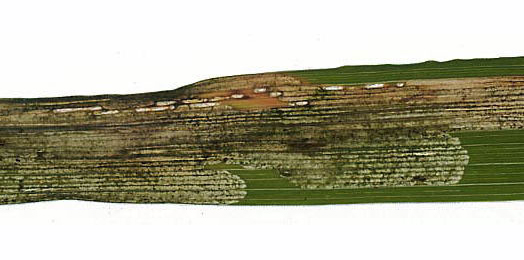 Mine of Agromyza nigrociliata on Arrhenatherum elatius Image: © Willem Ellis (Bladmineerders van Europa) |
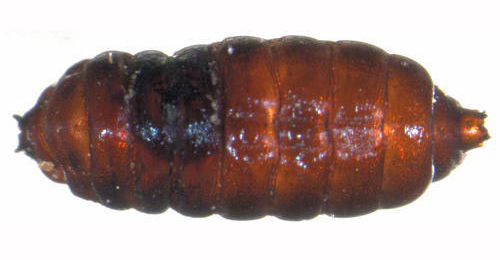 Agromyza nigrociliata puparium Image: © Willem Ellis (Bladmineerders van Europa) |
|
Agromyza nigrociliata Hendel, 1931 [Diptera: Agromyzidae]. |
2h > Leaf-miner: Mine greenish with only single larva, initially running towards apex of leaf before turning back down and developing into a broad blotch. Puparium reddish brown |
|
Agromyza rondensis Strobl, 1900 [Diptera: Agromyzidae]. |
2i > Leaf-miner: A narrow whitish linear mine, running down the leaf from the apex, with frass in two rows of separate grains. Pupation external (Spencer, 1976: 246). Narrow corridor from start to end, whitish, uppper- or lower-surface, genarally running downwards. Mine often along the leaf margin. Frass in distict grains of regular size, alternating along the sides of the corridor. Pupation outside the mine. |
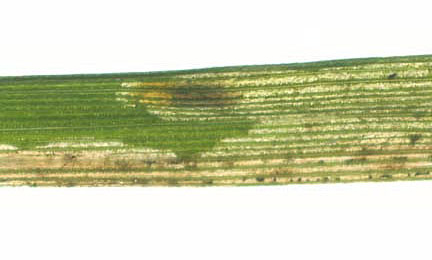 Mine of Liriomyza flaveola on Festuca gigantea Image: © Willis Ellis (Bladmineerders van Europa) |
|
Liriomyza flaveola (Fallén, 1823) [Diptera: Agromyzidae]. |
2j > Leaf-miner: Irregular mine, locally shallow, elsewhere much deeper, giving it a mottled appearance. In broadleaved plants the mine often begins as a blotch with stellate extensions, but sometimes as a very fine, shallow corridor. In grasses the mine often begins in the leaf sheath. The frass is very fine-grained, initially scattered, later in aggregates. The egg is deposited on the plant surface, and the empty egg shell remains visible. But the larvae are able to leave their mine and restart elsewhere, thus mines without an egg shell can be found as well. The larva also leaves the mine before pupation. Pupation takes place in a newly made, small, blotch mine without frass; this mine may be made in another plant (species). |
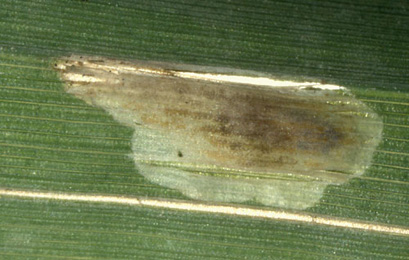 Mine of Hydrellia griseola on Glyceria fluitans Image: © Willem Ellis (Bladmineerders van Europa) |
|
Hydrellia griseola (Fallén, 1813) [Diptera: Ephydridae]. |
| Last updated 07-Jul-2019 Brian Pitkin | ||
